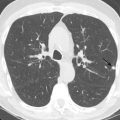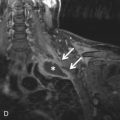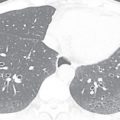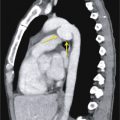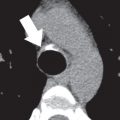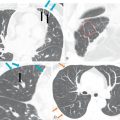■
Conventional Chest X-Ray
The chest radiograph is the most common radiographic procedure performed in the imaging department and is the initial imaging modality in a patient presenting with thoracic symptoms. The basic techniques of chest radiography have not changed significantly over the past 100 years. However, most centers are now using predominantly digital radiology as compared to the conventional screen-film technology.
Preliminary Considerations
W hy do we choose digital over analog ?
- 1.
Image acquisition and display functions can be controlled separately.
- 2.
Postprocessing in a workstation is possible for optimal display.
- 3.
Archiving, distribution, and copying are easier.
- 4.
The same unit is used for acquisition and processing.
Posteroanterior (PA) and lateral views are the basic views for the evaluation of chest pathology.
H ow do you obtain a PA film ?
- 1.
The position of x-ray source (tube) is posterior to the patient (standard distance is 6 feet).
- 2.
The position of the detector (film) is immediately in front of the patient.
- 3.
The patient stands in front of the detector, with his or her shoulders rotated forward and places the wrists on the iliac crests so that the scapulae are held as far to the side of the chest as possible.
- 1.
Space—to acquire radiographs at a focus-film distance of 6 feet.
- 2.
High kilovoltage machines (140-kVp [peak kilovoltage] technique) preferred.
- 3.
Grid (reduces scatter)
- 4.
Phototimer (controls exposure length)
An air gap of 15-cm depth is often used with a high-kilovoltage technique instead of a grid. The effectiveness and radiation dose are similar with this technique, as with a grid.
H ow do you know that the frontal pa radiograph is optimum ?
- 1.
Exposure. A proper exposure on the frontal radiograph is defined by faint visualization of the intervertebral disk spaces (thoracic spine) and identification of branching vessels in the retrocardiac region ( Fig. 5.1 ). On a lateral radiograph, there should be proper contrast and density to visualize the ribs through the heart, lung markings, and sharp outlines of the hemidiaphragms ( Fig. 5.2 ).

Figure 5.1
Proper exposure and centering of a posteroanterior chest radiograph. A proper exposure is defined by faint visualization of the lower intervertebral disk spaces (arrow). Distance from the medial ends of clavicles (anterior structure) to the midline spinous processes of thoracic spine (posterior structure) is equal on both sides (stars) indicating proper centering.

Figure 5.2
Proper exposure and centering of a lateral chest radiograph. Points to note for proper positioning are sternum in profile, open intervertebral foramina, and superimposed bilateral anterior and posterior ribs evidencing correct lateral positioning. The soft tissues and bones of arms are not overlapping the lung field. Proper exposure is evidenced by visualization of the ribs through the heart, lung markings, and sharp outlines of the hemidiaphragms.
- 2.
Centering. The distance from the medial ends of clavicles (anterior structure) to the midline spinous process of the thoracic spine (posterior structure) should be equal on both sides (see Fig. 5.1 ).
- 3.
Appropriate inspiratory effort. Identify when the apex of the right hemidiaphragm is below the level of the tenth posterior rib.
- 4.
Respiratory patient motion. The pulmonary vasculature, diaphragm, and cardiomediastinal outline should be sharply marginated.
Full inspiration is done so that a radiograph at total lung capacity can be obtained. A breath-hold is used to minimize breathing-related artifacts.
W hat will happen if the x – ray is taken during expiration ?
This falsely enhances the interstitial markings, with a widened cardiomediastinal outline ( Fig. 5.3 ).

H ow do we know correct positioning on the frontal radiograph ?
The thoracic spinous processes should be at the same distance from the medial ends of the clavicles. The scapulae should be placed laterally by rotating the shoulders forward (see Fig. 5.1 ).
H ow do we know correct positioning on the lateral radiograph ?
Visualizing the sternum in profile, an open intervertebral foramina, superimposed bilateral anterior, and posterior ribs suggest correct lateral positioning. The soft tissues and arm bones should not be superimposed over the lung field (see Fig. 5.2 ). Tilting of the upper thorax can be appreciated by localized, narrowed, disk spaces of the thoracic vertebrae.
H ow do you select kilovoltage for screen film imaging ?
It is hard to obtain a suitable exposure to evaluate both soft tissues and lung in a single film due to the steep, S -shaped, dose-response curve of radiographic film. Different techniques are used to obtain an optimum radiograph when using film screen imaging. One helpful way is to use a high-kilovoltage technique (>120 kV) and a wide-latitude film.
W hat are the advantages of high – kilovoltage techniques ?
- 1.
There is less obscuration of lung parenchyma by bony structures because the differences in coefficients of x-ray absorption of bones and soft tissues are minimized.
- 2.
There is better penetration of the mediastinum, improving the visualization of airways.
- 3.
Exposure time decreases, reducing motion artifact.
- 1.
Increased contrast between aerated lung and blood filled vessels gives better detail of the lung parenchyma—part of the lung parenchyma is not obscured by overlying bones.
- 2.
Some lesions are better seen on low kilovoltage, such as calcification (e.g., pleural plaques) and lung nodules.
Rare earth phosphor screens are preferred over calcium tungstate crystal screens because the improved light emission capability of rare earth phosphor screens reduces exposure time and gives sharper images.
Wide-latitude, low-contrast films are preferred in chest radiography because of the highly attenuated mediastinum and highly transmissive lung fields. Otherwise the cardiac outline would be too white and the lung parenchyma would be too dark on a processed film. Studies have shown that using a twin screen-film cassette gives a wide latitude, which helps with the proper visualization of the mediastinal soft tissues and air-filled lung.
W hat is scanning equalization radiography ?
There is a significant difference in x-ray attenuation between the air-filled lung and soft tissues such as the mediastinum and diaphragm, precluding uniform exposure and increasing the scatter. One way to obtain a uniform exposure is the use of scanning equalization radiography (SER). This is a computer-assisted, electronically enhanced radiography technique in which a narrow x-ray beam is scanned over the patient, and its attenuation is measured. The beam intensity is then modulated, depending on this information to equalize the regional x-ray film exposure. An artificial dark band is created at the interfaces of high contrast, such as the diaphragm-lung interface.
W hat is AMBER?
AMBER stands for a dvanced m ultiple- b eam e qualization r adiography, one of the most widely used SER technologies. A horizontally oriented slit beam is used with this unit to scan the chest. The detectors are electronically connected to receive feedback information for changing exposure variables for different thickness of tissues.
W hy use other views if PA and lateral views are the best ?
It is not always possible to obtain a PA view (e.g., in an intensive care unit [ICU] setting); sometimes one can use an additional view to answer a specific clinical question. However, many views that were formerly used are no longer performed due to the easy availability of CT, which gives a more definite answer. Note that the cost of an additional radiographic view is still significantly less than a CT scan, and an additional view may solve a particular clinical question quickly and economically.
Standard Views
W hat other views are still currently performed , and why ?
Anteroposterior View
Most portable radiographs (e.g., in an ICU setting) are performed in the anteroposterior (AP) projection. The main advantage of this position is that it can be done without changing the patient’s position.
why not use AP views in all patients ?
- 1.
There is more magnification in an AP radiograph as compared to a PA radiograph due to a shorter focus-film distance. The heart is an anterior structure and is therefore magnified, suggesting apparent cardiomegaly (see Fig. 5.3 ). The apparent cardiac diameter may increase by 15% to 20% in the AP position.
- 2.
One cannot use high-kilovoltage techniques for portable x-rays because portable machines have a limited kilovoltage setting. Similarly, maximum milliamperage is also limited as compared to stationary machines.
- 3.
Grids to decrease scatter are not as effective.
- 4.
Due to limited maximal kilovoltage capability, portable machines require longer exposures to have a proper penetration, resulting in increased motion-related artifacts.
- 5.
Images are often rotated because critically ill patients are difficult to position.
- 6.
Supine positioning elevates the diaphragm and compresses the lower lobes, thereby reducing lung volumes.
- 7.
Because there is even a gravitational effect in the upper and lower lung zones, evaluation of pulmonary vascular congestion is often difficult on supine images.
- 8.
The upper mediastinum is widened due to magnification and an increase in systemic venous return in the supine position.
- 9.
Small effusions may be missed due to a layering effect in a supine patient.
- 10.
A small pneumothorax may be missed because free air tends to move to an anteromedial or inferior location in a supine patient.
It is commonly used to evaluate cardiopulmonary status and various monitoring devices in an inpatient, particularly in the ICU setting. A sharper reconstruction algorithm is often used to evaluate positioning of support lines on a radiograph ( Fig. 5.4 ).


